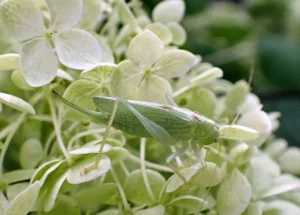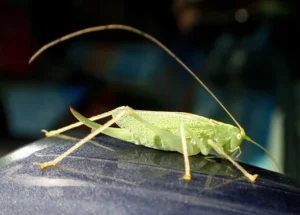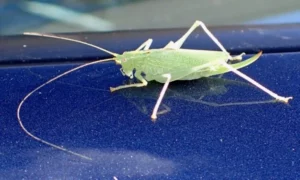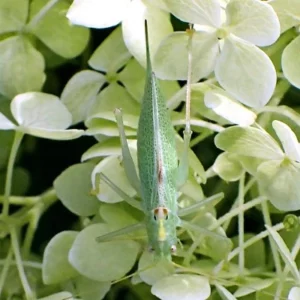Note: All links leave to external sites.
Howdy, BugFans,
Sometimes you go looking for insects, and sometimes the insects find you. The BugLady came back to her car from the Post Office one sunny afternoon in August and discovered this stunning katydid sitting above the driver’s door of her car. Keeping one eye on traffic, she managed to get a few shots of it before moving it to a nearby hydrangea.
She had never heard of the Drumming katydids before. They’re in the katydid family Tettigoniidae and in the subfamily Meconematinae, the Quiet-calling Katydids, which has about 200 species worldwide. Three of the members of the subfamily make sounds that we can’t hear without the aid of an ultrasonic detector, and both of the species that occur in North America have been introduced.
Other names for the Drumming katydid (Meconema thalassinum) are the Oak Bush-Cricket (in Britain), Méconème Tambourinaire (not in Britain), Eichenschrecke (Oak locust) in Germany, Quiet-calling katydid, and Sea-Green Katydid (“thalassinum” means “sea green.”

This European katydid was first recorded in America in 1957 in western Long Island. By 2004 it had made its way to Michigan, and now it inhabits much of the northeast quadrant of North America plus the Pacific Northwest. It’s found in deciduous trees and in the vegetation below them; neither cars nor hydrangeas are listed as potential habitats, but the BugLady found a few other shots of Drumming katydids sitting on cars, and sources note that they are comfortable on and around man-made structures.
Lots of members of the grasshopper/katydid bunch are known to spice up their vegetarian existence with a little protein by nibbling on dead insects or insect eggs. Some sources say that Drumming katydids do exactly that, but others say that they are exclusively carnivorous, feeding on aphids and small larvae. They aren’t considered plant pests in either the Old Country or the New.
What eats them? The usual suspects, plus they are among the grasshopper/katydid species that Grass-carrying wasps (Isodontia) collect to provision their egg chambers. Drumming katydids are also susceptible to a parasitic worm that takes over their nervous system and tells the katydid to head for any nearby body of water so that the worm can emerge there.

Drumming katydids aren’t huge – maybe 4/5 of an inch long (plus the ovipositor, though the one she saw seemed bigger to the BugLady). They have a hearing organ (tympanum) on each of their front legs (if you’re going to sing, you should have “ears” to hear it). They have yellow feet, and because they’re katydids, they have extra-long antennae – pale orange, in their case. Females have a long, curved ovipositor and males have long, slender, curved, hollow claspers (cerci). They are nocturnal.

Though males do have tiny teeth on their forewings (scientists aren’t sure why, unless it’s to add an ultrasonic stridulation/friction component to the katydid’s acoustic repertoire), they don’t have rough spots (stridulatory areas) at the base of their forewings, so they don’t use the usual katydid “file and scraper” modus operandi to attract a female. Instead, they tap/drum a quick Morse code on a leaf with their hind tarsus – the tarsus is basically a five-segmented foot, and males have a hard pad on the first tarsal segment that females don’t. Though the pattern of his song stays the same, the higher the temperature is, the more frequently he taps. The soft sound may be heard by a human (one with better hearing than the BugLady’s) as far as 12 feet away, and it’s believed that the vibrations also travel through the substrate, but the BugLady couldn’t discover exactly how the female detects his signals.
There’s only one generation per year – they overwinter as eggs that hatch in late spring and are mature by mid-August, and adults may be seen well into late fall. Drumming katydids are small, and they lay their eggs in bark crevices, and it’s suspected that they made their way to America on imported plant material.
The BugLady
